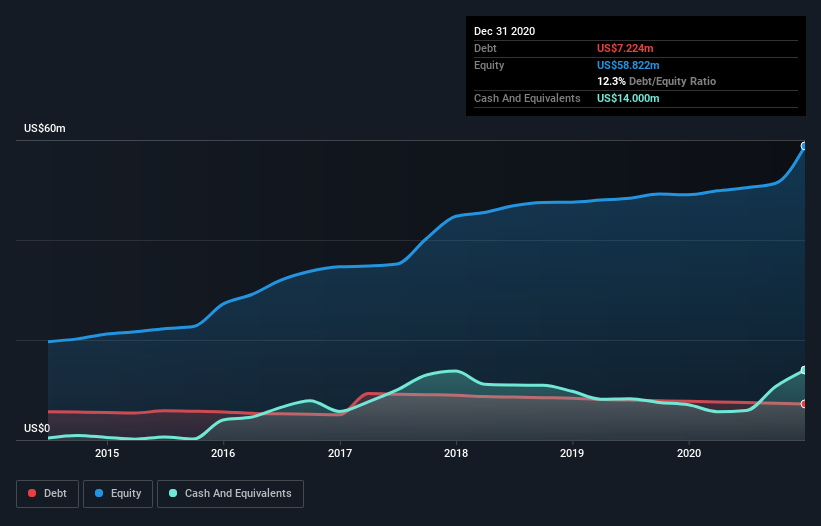- United States
- /
- Beverage
- /
- NasdaqCM:WVVI
Willamette Valley Vineyards (NASDAQ:WVVI) Has A Pretty Healthy Balance Sheet

Warren Buffett famously said, 'Volatility is far from synonymous with risk.' It's only natural to consider a company's balance sheet when you examine how risky it is, since debt is often involved when a business collapses. As with many other companies Willamette Valley Vineyards, Inc. (NASDAQ:WVVI) makes use of debt. But the more important question is: how much risk is that debt creating?
What Risk Does Debt Bring?
Generally speaking, debt only becomes a real problem when a company can't easily pay it off, either by raising capital or with its own cash flow. If things get really bad, the lenders can take control of the business. However, a more frequent (but still costly) occurrence is where a company must issue shares at bargain-basement prices, permanently diluting shareholders, just to shore up its balance sheet. Of course, plenty of companies use debt to fund growth, without any negative consequences. The first step when considering a company's debt levels is to consider its cash and debt together.
View our latest analysis for Willamette Valley Vineyards
What Is Willamette Valley Vineyards's Debt?
As you can see below, Willamette Valley Vineyards had US$7.22m of debt at December 2020, down from US$7.73m a year prior. But on the other hand it also has US$14.0m in cash, leading to a US$6.78m net cash position.

A Look At Willamette Valley Vineyards' Liabilities
Zooming in on the latest balance sheet data, we can see that Willamette Valley Vineyards had liabilities of US$7.30m due within 12 months and liabilities of US$13.4m due beyond that. Offsetting this, it had US$14.0m in cash and US$3.16m in receivables that were due within 12 months. So it has liabilities totalling US$3.51m more than its cash and near-term receivables, combined.
Given Willamette Valley Vineyards has a market capitalization of US$74.3m, it's hard to believe these liabilities pose much threat. Having said that, it's clear that we should continue to monitor its balance sheet, lest it change for the worse. While it does have liabilities worth noting, Willamette Valley Vineyards also has more cash than debt, so we're pretty confident it can manage its debt safely.
On top of that, Willamette Valley Vineyards grew its EBIT by 34% over the last twelve months, and that growth will make it easier to handle its debt. There's no doubt that we learn most about debt from the balance sheet. But it is Willamette Valley Vineyards's earnings that will influence how the balance sheet holds up in the future. So if you're keen to discover more about its earnings, it might be worth checking out this graph of its long term earnings trend.
But our final consideration is also important, because a company cannot pay debt with paper profits; it needs cold hard cash. Willamette Valley Vineyards may have net cash on the balance sheet, but it is still interesting to look at how well the business converts its earnings before interest and tax (EBIT) to free cash flow, because that will influence both its need for, and its capacity to manage debt. During the last three years, Willamette Valley Vineyards burned a lot of cash. While investors are no doubt expecting a reversal of that situation in due course, it clearly does mean its use of debt is more risky.
Summing up
We could understand if investors are concerned about Willamette Valley Vineyards's liabilities, but we can be reassured by the fact it has has net cash of US$6.78m. And it impressed us with its EBIT growth of 34% over the last year. So we don't have any problem with Willamette Valley Vineyards's use of debt. The balance sheet is clearly the area to focus on when you are analysing debt. However, not all investment risk resides within the balance sheet - far from it. To that end, you should be aware of the 2 warning signs we've spotted with Willamette Valley Vineyards .
Of course, if you're the type of investor who prefers buying stocks without the burden of debt, then don't hesitate to discover our exclusive list of net cash growth stocks, today.
When trading Willamette Valley Vineyards or any other investment, use the platform considered by many to be the Professional's Gateway to the Worlds Market, Interactive Brokers. You get the lowest-cost* trading on stocks, options, futures, forex, bonds and funds worldwide from a single integrated account. Promoted
If you're looking to trade Willamette Valley Vineyards, open an account with the lowest-cost platform trusted by professionals, Interactive Brokers.
With clients in over 200 countries and territories, and access to 160 markets, IBKR lets you trade stocks, options, futures, forex, bonds and funds from a single integrated account.
Enjoy no hidden fees, no account minimums, and FX conversion rates as low as 0.03%, far better than what most brokers offer.
Sponsored ContentValuation is complex, but we're here to simplify it.
Discover if Willamette Valley Vineyards might be undervalued or overvalued with our detailed analysis, featuring fair value estimates, potential risks, dividends, insider trades, and its financial condition.
Access Free AnalysisThis article by Simply Wall St is general in nature. It does not constitute a recommendation to buy or sell any stock, and does not take account of your objectives, or your financial situation. We aim to bring you long-term focused analysis driven by fundamental data. Note that our analysis may not factor in the latest price-sensitive company announcements or qualitative material. Simply Wall St has no position in any stocks mentioned.
*Interactive Brokers Rated Lowest Cost Broker by StockBrokers.com Annual Online Review 2020
Have feedback on this article? Concerned about the content? Get in touch with us directly. Alternatively, email editorial-team (at) simplywallst.com.
About NasdaqCM:WVVI
Willamette Valley Vineyards
Produces and sells wine in the United States and internationally.
Mediocre balance sheet and slightly overvalued.
Similar Companies
Market Insights
Community Narratives




